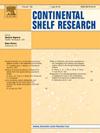Analysis of the uncertainties in tidal constants obtained from short tide gauge records and their value for tidal studies
IF 2.2
3区 地球科学
Q2 OCEANOGRAPHY
引用次数: 0
Abstract
We conduct a study to estimate uncertainties in tidal constants from M2, S2, N2, K1, O1, Q1 and related K2, P1, 2N2 constituents from 35-day tide gauge records in the northern Australia and Papua New Guinea regions. The motivation for this study stems from the availability of ∼300 short tide gauge records (most ∼ 30 days long) in these regions, but their accuracy for tidal studies is not clear. We simulate the 35-day uncertainties by dividing a selected set of 14 long tide gauge records (19-years where available) from the GESLA3 data set into consecutive 35-day sections. Amplitudes and phase lags computed from each long record are treated as the ‘true’ values, from which we compute and analyse inference information for the short records. Comparison of empirical amplitude ratios and phase lag differences with the relationships from the Equilibrium tide show significant differences in both amplitude and phase lag in some constituents and locations. We also compare inference information derived from the FES2022b ocean tide model, which suggests that such models could be used in this way in some instances. Empirical uncertainties in the 35-day records were no more than 0.045 m with maximum errors reaching 0.093 m. The largest 35-day errors appeared in the K1 constituent, mostly in the Torres Strait and northwest Australia. Empirical inference information showed improvement on the Equilibrium assumption for S2 and K1 reference constituents and related constituents K2, 2N2 and P1, demonstrating that the latter can be accurately derived from short records with accurate inference information.
短验潮仪记录潮汐常数的不确定度分析及其对潮汐研究的价值
利用澳大利亚北部和巴布亚新几内亚地区35 d验潮仪记录,对M2、S2、N2、K1、O1、Q1及相关的K2、P1、2N2组分潮汐常数的不确定性进行了估算。这项研究的动机源于这些地区约300个短潮汐计记录(大多数约30天)的可用性,但它们对潮汐研究的准确性尚不清楚。我们通过将GESLA3数据集中的14个长潮汐计记录(如有19年)划分为连续的35天段来模拟35天的不确定性。从每个长记录中计算的振幅和相位滞后被视为“真实”值,从中我们计算和分析短记录的推理信息。将经验振幅比和相位滞后差与平衡潮的关系进行比较,可以发现某些成分和位置的振幅和相位滞后都存在显著差异。我们还比较了从FES2022b海潮模型得到的推断信息,这表明这些模型可以在某些情况下以这种方式使用。35 d记录的经验不确定度不大于0.045 m,最大误差为0.093 m。最大的35天误差出现在K1组成部分,主要在托雷斯海峡和澳大利亚西北部。经验推断信息对S2和K1参考成分以及相关成分K2、2N2和P1的平衡假设进行了改进,表明后者可以通过准确的推断信息准确地从短记录中推导出来。
本文章由计算机程序翻译,如有差异,请以英文原文为准。
求助全文
约1分钟内获得全文
求助全文
来源期刊

Continental Shelf Research
地学-海洋学
CiteScore
4.30
自引率
4.30%
发文量
136
审稿时长
6.1 months
期刊介绍:
Continental Shelf Research publishes articles dealing with the biological, chemical, geological and physical oceanography of the shallow marine environment, from coastal and estuarine waters out to the shelf break. The continental shelf is a critical environment within the land-ocean continuum, and many processes, functions and problems in the continental shelf are driven by terrestrial inputs transported through the rivers and estuaries to the coastal and continental shelf areas. Manuscripts that deal with these topics must make a clear link to the continental shelf. Examples of research areas include:
Physical sedimentology and geomorphology
Geochemistry of the coastal ocean (inorganic and organic)
Marine environment and anthropogenic effects
Interaction of physical dynamics with natural and manmade shoreline features
Benthic, phytoplankton and zooplankton ecology
Coastal water and sediment quality, and ecosystem health
Benthic-pelagic coupling (physical and biogeochemical)
Interactions between physical dynamics (waves, currents, mixing, etc.) and biogeochemical cycles
Estuarine, coastal and shelf sea modelling and process studies.
 求助内容:
求助内容: 应助结果提醒方式:
应助结果提醒方式:


